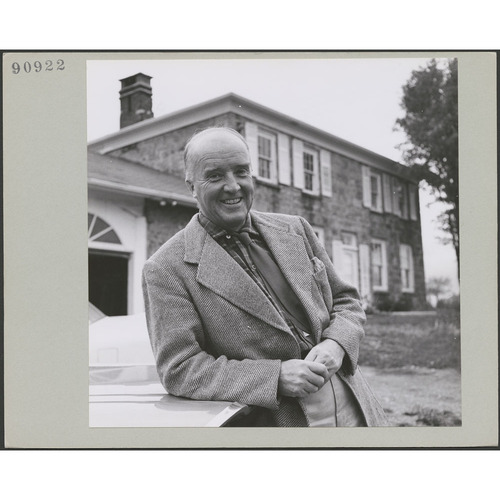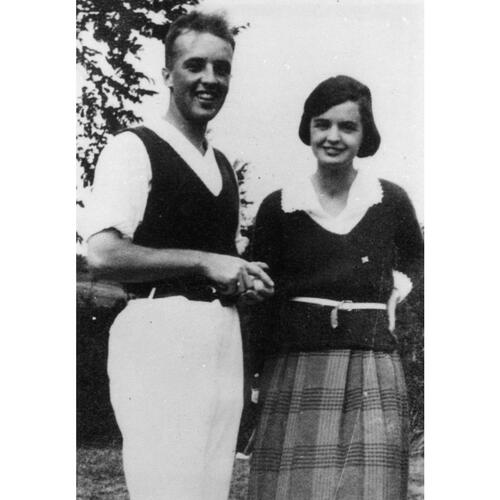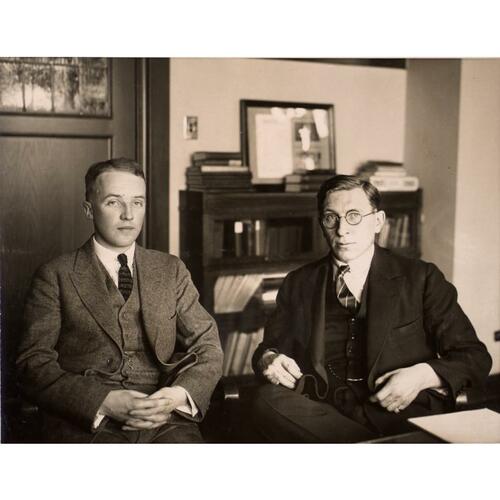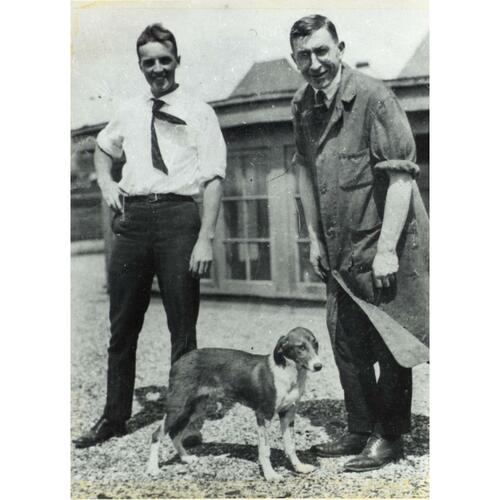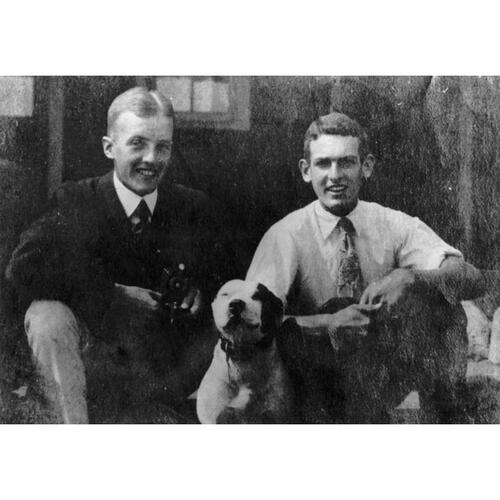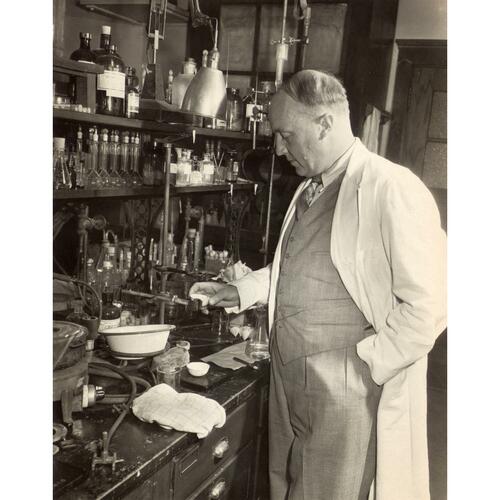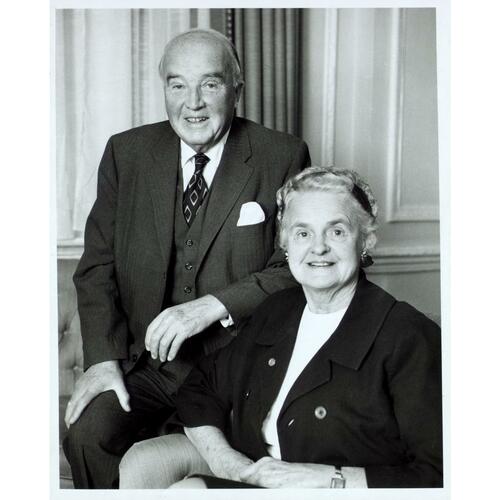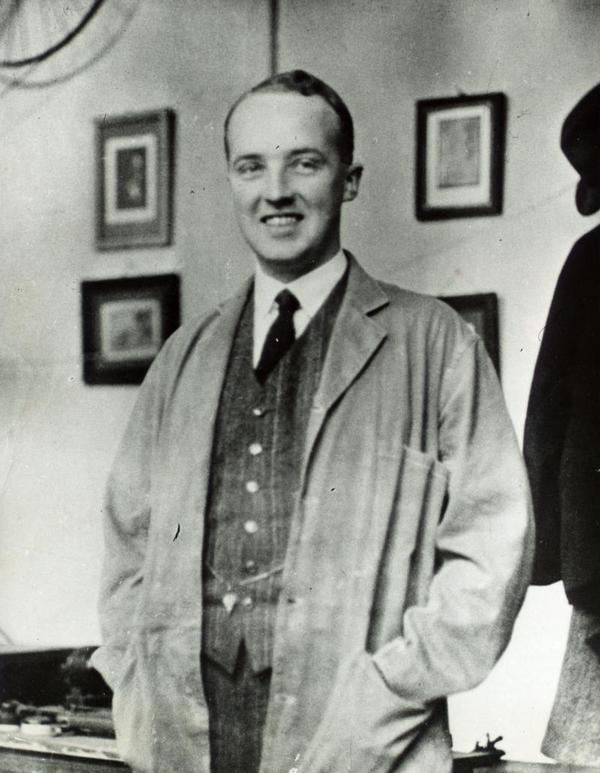
Source: Link
BEST, CHARLES HERBERT, physiologist, medical researcher, and university teacher; b. 27 Feb. 1899 in Pembroke, Maine, second child and only son of Herbert Huestis Best and Luella May Fisher (known as Lulu Newcomb); m. 3 Sept. 1924 Margaret Hooper Mahon in Toronto, and they had two sons; d. there 31 March 1978.
His involvement in the discovery of insulin was both the high point of Charles H. Best’s life and the source of a lifetime of regret that he was not given the recognition he thought he deserved.
The son of a Canadian-born country doctor practising in Maine, Charley, as he was called by his family, was educated locally, took his final year of high school in Toronto, where he had relatives, and entered the University of Toronto in 1916. At the beginning of his second year in a general arts course he transferred into the honours physiology and biochemistry program. He interrupted his education to serve in the Canadian army late in World War I, but did not reach the front, and returned to the university, where he earned his bachelor of arts degree in the spring of 1921. Intending to take an ma, Best accepted a summer position as one of two student assistants to the professor of physiology, John James Rickard Macleod*.
In a Macleod lecture the previous winter Best had first heard mention of Dr Frederick Grant Banting*, who might be coming to Toronto to test an idea for research aimed at finding the elusive internal secretion of the pancreas, a substance that was thought to hold the key to the regulation of metabolism. Macleod asked Best and the other student assistant, Edward Clark Noble, to help Banting with his project. Many years later, when Best began constructing a narrative of this early period in his career, he said that he had been eager to work with Banting because of an interest he had in diabetes mellitus, which had claimed the life of one of his aunts. Anxious to crush any idea that his fame had been shaped by good luck, Best denied that he and Noble had flipped a coin to see who would work with Banting first. Both Banting and Noble thought there had been a coin toss.
Best assisted Banting in the animal experiments in the summer of 1921 that led to exciting results from their administering extracts of dog pancreas to depancreatized, diabetic dogs. His primary responsibility was to carry out blood-sugar and other biochemical tests, but he also helped with Banting’s surgical procedures on the dogs. While Best was away from the lab for militia training in the middle of June, Noble performed some of the tests. On Best’s return, Banting firmly insisted that he do better work. Noble and Best agreed that there was no point in Noble taking over in the middle of the project.
Banting and Best had no further friction, enjoyed considerable fellowship as they carried out a complex plan of experiments, and at times behaved as partners. Best’s name, for example, was on all of the articles reporting the results of the research. Banting was clearly the senior partner, however, both in organizing experiments and in dealing with the director of the lab, Macleod. In December Best was somewhat disgruntled when Macleod, at Banting’s urging, invited the trained biochemist James Bertram Collip* to join the team with a view to applying more expertise to the study and purification of the pancreatic extracts they were using.
Best appears to have gone about his business during the triumphant but tragic events of January 1922. Extract made by Collip succeeded splendidly in the key human trial following a failed test of Banting and Best’s extract. Unfortunately, Banting, who had begun to worry that Macleod and Collip were inappropriately taking credit for the research, had a violent confrontation with the latter in the lab. Best separated them. Along with the others, he signed an agreement on 25 January in which they pledged to work together under Macleod’s direction.
Collip was assigned the lead role in producing extracts. Macleod distributed research tasks to other members of the group, including Best. Within a few weeks Collip began having serious problems producing effective extract, now named insulin. Best urged Banting, whose role had become marginal and who was breaking down under intense stress, to return to the lab in an effort to rediscover the secret. Banting was deeply grateful for Best’s support during this crisis. It became even more important to him when Best and Macleod managed to develop procedures for making small quantities of potent insulin and Best gave this product to Banting to administer to patients, thus fortifying the latter’s position in the struggle for influence and recognition.
When Collip left Toronto late that spring to return to the University of Alberta, Best was made director of insulin production at the University of Toronto’s fledgling Connaught Antitoxin Laboratories [see John Gerald FitzGerald*]. By this time a joint venture had been arranged with Eli Lilly and Company of Indiana; the university’s insulin committee would administer patents on the manufacturing process. These had been taken out in the names of Banting, Best, and Collip and transferred to the university’s board of governors. Lilly then played the lead role in the development of insulin.
By late 1922 it had become clear that the discovery of insulin was one of the great therapeutic breakthroughs in the history of medicine. A complex and major struggle for credit developed, with Banting’s well-placed Toronto friends, notably his politically savvy former teacher Dr George William Ross, leading a campaign to have him recognized as the sole discoverer. Banting’s champions tended to ignore Best as simply an assistant. Best resented the exclusion and made his unhappiness known to Banting, whose feelings about Best’s role tended to vary with his moods. The campaign to honour Banting largely succeeded with the governments of Ontario and Canada.
In Stockholm, however, the Nobel Committee of the Karolinska Institutet decided that Banting could not have made the discovery without the leadership of Macleod, and it recommended that the 1923 prize in physiology or medicine be given to Banting and Macleod. Banting was furious at the recognition of Macleod. After being talked out of rejecting the award, he sent a telegram to Harvard, where Best was giving a talk: “I ascribe to Best equal share in the discovery stop hurt that he is not so acknowledge[d] by Nobel trustees stop will share with him.” Banting divided his Nobel Prize money with Best. Macleod released a statement stressing the collaborative nature of the research and the equal role that Collip had played. He divided his prize money with Collip.
Best received his master’s degree in 1923 for one of his projects during the insulin research. Two years later he completed work for Toronto’s basic degree of bachelor of medicine. Showered with prizes and fellowships and happily married since September 1924 to the beautiful Margaret Mahon, Charley took wise advice to leave Toronto in order to do advanced graduate work under the supervision of the distinguished British physiologist Henry Hallett Dale. Dale became an influential role model, patron, and friend. Best received his doctor of science degree from the University of London in 1928, having returned the previous year to the University of Toronto as an assistant professor, soon to become head of the department of physiological hygiene. In 1929 he was invited also to succeed Macleod as professor and chairman of the department of physiology.
After the insulin research there was no further collaboration between Best and Banting. The latter held an independent research chair in the university that gradually evolved into its Banting and Best department of medical research. In his realm Best pursued a variety of projects, investigating the dietary factor choline, studying the physiology of Olympic athletes, and gradually focusing efforts on the purification of the anticoagulant heparin, which had been discovered at Johns Hopkins University. The heparin work became a major and fast-moving project at Toronto, leading to important pioneering use of the substance in surgery and polite, but sometimes contradictory, claims for credit among researchers in Toronto and other centres. Best also lent his name to a textbook, The physiological basis of medical practice … (Baltimore, Md, 1937), largely written by a member of his department, Norman Burke Taylor, which was widely adopted in medical schools.
The University of Toronto had named a new medical building the Banting Institute in 1930. Best soon began lobbying for an institute to bear his name, an expression of ambition that did not impress Banting. Their relationship was coolly formal. It ended particularly sadly when Best, for family reasons, decided not to undertake a research liaison trip to wartime England in the winter of 1940–41. Deeply angry at Best and driven by his own aspirations, Banting decided to go instead. He died in the crash of a bomber being flown to Britain on which he had, in effect, hitched a ride. Best was appointed his successor as director of the department of medical research. In 1953 the University of Toronto opened the Charles H. Best Institute, next door to the Banting.
Best had done useful work during World War II on blood-transfusion services and for the Canadian navy on problems of night vision and motion sickness. After the war his attention increasingly turned back to diabetes, both as a field for research and because of his role as one of the two living discoverers of insulin. As an elder scientific statesman, he attracted several talented diabetes researchers to Toronto, who rebuilt the city’s capacity for investigation in that area, and he was one of the founders of the Canadian Diabetes Association. He and Margaret enjoyed circulating in international medical circles, and he was not reluctant to accept honours – his list of medals, memberships, and honorary degrees is very long – or to retell the story of the discovery of insulin to his advantage.
The several accounts of the insulin research that Best published after 1946 contain many claims – both for equal partnership with Banting and in denigrating the contributions of Macleod and Collip – that are not consistent with the evidence of the primary sources, including some of his own writing. In private communications with an erstwhile biographer and others, such as Sir Henry Dale, Best revealed a hunger for recognition that led him perilously close to deliberate falsification of the historical record. Some of his admirers fed his appetite by nominating him for Nobel prizes and still more honours. Others realized that deeper psychological currents were in play, some of them possibly relating to an inherited predisposition to depression. In the early 1960s various stressful events, professional and familial, resulted in episodes of clinical depression sufficiently debilitating to require the administration of electroshock therapy.
Best then gradually slipped into retirement, still honoured and revered to a fault by grateful insulin users. He had been much troubled by the misadventures of his elder son, Charles Alexander, for whose forays into business and politics he had had high hopes. In March 1978 news of Sandy Best’s sudden death at the age of 46 caused his father to collapse and die in hospital a few days later.
In his early twenties and while he was still a student, Charles Best had become one of the discoverers of insulin. A handsome and charming man, well connected and widely admired, and with a career that would satisfy many, he lived to become one of the most honoured scientists of the 20th century. From 1923 on he knew that the greatest scientific laurel, the Nobel Prize for the discovery of insulin, would forever elude him. So did peace of mind about his role in the insulin saga and the position that he and his family had achieved in Canada. It cannot be known whether he would have had a more contented life if the coin he tossed with Clark Noble had landed the other side up.
The Charles Herbert Best papers (ms coll. 241) in the Thomas Fisher Rare Book Library, Univ. of Toronto, are the major manuscript collection covering most aspects of Best’s life and include his wife’s extensive diaries. Almost as important are the William R. Feasby papers (ms coll. 235), also in the Fisher Library, which contain a full record of Best’s project in the 1950s to have Feasby write his biography, including a first draft of the book corrected in Best’s hand. The Fisher Library’s other major holdings relating to the discovery of insulin, particularly the Sir Frederick Grant Banting papers (ms coll. 76), are also essential. The Toronto insulin material is extensively described and sampled on the website “The discovery and early development of insulin”: link.library.utoronto.ca/insulin (consulted 21 Oct. 2014).
A lengthy and detailed biography of Charles Best and his wife, Margaret and Charley: the personal story of Dr. Charles Best, the co-discoverer of insulin (Toronto and Oxford, Eng., 2003), written by their historian son Henry Bruce Macleod Best, is the standard, if occasionally muddled, published life. It can be completed by Selected papers of Charles H. Best (Toronto, 1963). As explained in this biography, however, Best’s various published and unpublished narratives of the discovery of insulin cannot be taken as factually accurate, a problem explored in detail in Michael Bliss, “Rewriting medical history: Charles Best and the Banting and Best myth,” Journal of the Hist. of Medicine and Allied Sciences (New Haven, Conn.), 48 (1993): 253–74.
The standard published history of the discovery is Michael Bliss, The discovery of insulin (Toronto, 1982; 25th anniversary ed., 2007), which also contains extensive bibliographic references. In Banting: a biography (Toronto, 1984; 2nd ed., 1992), Bliss says more about the relationship with Best, both during and after the insulin period. Key primary documents relating to the discovery of insulin have been published in the Bull. of the Hist. of Medicine (Baltimore, Md): J. J. R. Macleod’s “History of the researches leading to the discovery of insulin,” intro. L. G. Stevenson, 52 (1978): 295–312; “Banting’s, Best’s, and Collip’s accounts of the discovery of insulin,” intro. Michael Bliss, 56 (1982): 554–68; and Mark Jurdjevic and Caitlin Tillman, “E. C. Noble in June 1921, and his account of the discovery of insulin,” 78 (2004): 864–75. The standard history of the Univ. of Toronto and its medical faculty is M. L. Friedland, The University of Toronto: a history (Toronto, 2002).
Ancestry.com, “Maine, birth records, 1715–1922”: www.ancestry.com (consulted 20 Nov. 2017). Arch. of Ont. (Toronto), RG 80-5-0-1433, no.3972.
Cite This Article
Michael Bliss, “BEST, CHARLES HERBERT,” in Dictionary of Canadian Biography, vol. 20, University of Toronto/Université Laval, 2003–, accessed September 4, 2024, https://www.biographi.ca/en/bio/best_charles_herbert_20E.html.
The citation above shows the format for footnotes and endnotes according to the Chicago manual of style (16th edition). Information to be used in other citation formats:
| Permalink: | https://www.biographi.ca/en/bio/best_charles_herbert_20E.html |
| Author of Article: | Michael Bliss |
| Title of Article: | BEST, CHARLES HERBERT |
| Publication Name: | Dictionary of Canadian Biography, vol. 20 |
| Publisher: | University of Toronto/Université Laval |
| Year of publication: | 2018 |
| Year of revision: | 2018 |
| Access Date: | September 4, 2024 |


